Steps may be the quickest way up or down garden slopes, but that doesn’t mean they have to be mundane or just about utility. Minimalist designs might call for clean outlines of pristine stone and concrete, but in some gardens, especially traditional or smaller ones, steps can feel like wasted planting space.
How to plant the steps? You may want to make an ornamental feature, soften the hardscape, create a perfect spot for growing crevice-loving specimens or blend the steps in with your planting scheme. Often the only plants we find on steps are weeds that have to be grubbed out, in the words of the Victorian writer and poet Rudyard Kipling, “with broken dinner-knives.” But the fact that weeds find a happy domicile in these spaces shows us there is a range of plants that will happily inhabit them.
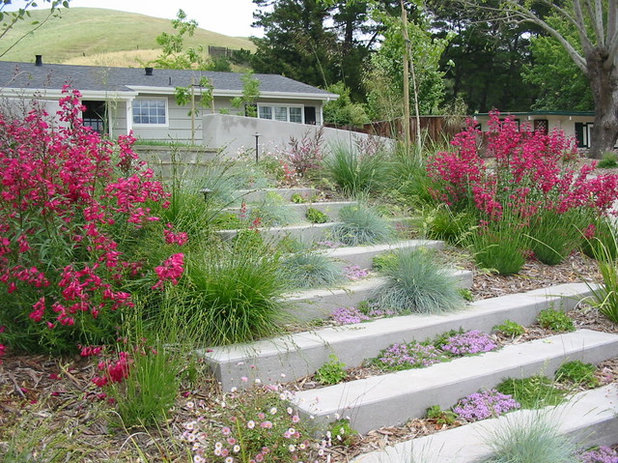
Huettl Landscape Architecture
Plant choice and maintenance are vital where steps and pathways need to be well lit and kept completely clear of trip and slip hazards, especially for people with restricted sight and mobility. Generally, plants should be creepers or low growing and carefully selected for the width of the step’s tread. Be sure to keep this in mind before planting your steps.
Poured-in-place-concrete steps interplanted with
Santa Barbara daisy (
Erigeron karvinskianus, USDA zones 6 to 9; find your zone), blue fescue (
Festuca glauca, zones 4 to 8),
creeping thyme (
Thymus praecox) and
Berkeley sedge (
Carex divulsa,
zones 4 to 10) lead to this California front yard.
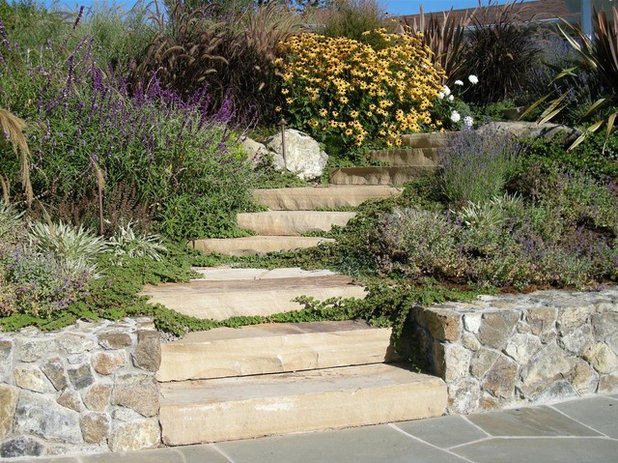
O'Connell Landscape
These cleft-stone steps become part of the perennial border as they wend their way through it. The planting creeps along the treads and meets in the center. The width of the tread allows easy passage without danger of anyone’s tripping, slipping or treading on the encroaching plants.
Plants that will achieve this effect include
creeping Jenny (
Lysimachia nummularia,
zones 3 to 9, shown here), perennials like
prostrate Veronica (
Veronica prostrata,
zones 4 to 8) and
woolly thyme (
Thymus pseudolanuginosus,
zones 5 to 8).
Cotoneaster microphyllus,
zones 5 to 9,
and
C. dammeri,
zones 5 to 8,
are two small-leaved evergreen shrubs that, with a bit of judicial pruning, will happily achieve the wanted effect.
See more plants for your pathway
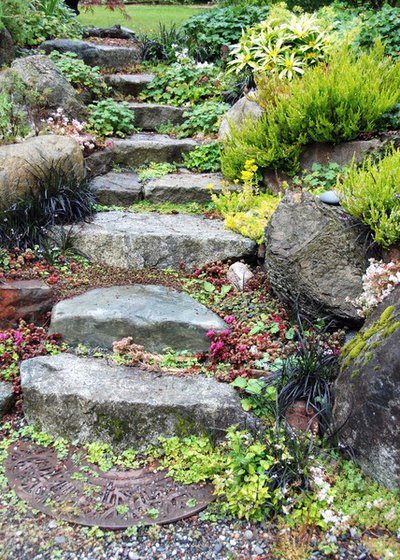
Exteriorscapes llc
Almost like stepping stones, these steps sit within a mixture of sedum plants that relish the conditions that the granite blocks create. Larger plants, including the black mondo grass (
Ophiopogon planiscapus ‘Nigrescens’, zones 5 to 10), are starting to colonize the crevices created at the sides and backs of the steps’ treads.
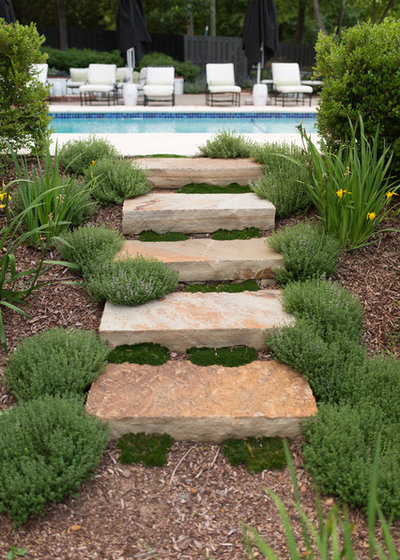
DK Design
Natural-stone steps are softened here by the plants in the crevices between the treads and risers, as well as by the low plantings in the adjacent borders that are allowed to encroach. To encourage suitable plants to grow, a space at the back of the tread needs to be left and filled with a well-draining compost or soil mix. This needs to be taken into account when the steps are being constructed to prevent any settlement caused by root growth that could affect the stability.
The plant choice is vital. You need to consider how ornamental you want the steps to be and how much room the plant will take up as well as the microclimate that the crevice conditions create. Though steps can protect plants from prevailing winds and scorching sun, they do tend to act as a storage heater, taking in daytime heat and releasing it at night. This encourages the growth of tenderer species but leads to very dry conditions in the crevices. An irrigation system may be required, or you’ll want to carefully select plants that will enjoy the hot, dry conditions.
Suitable plants tend to be compact or low growing and include some herbs, such as thyme (
Thymus spp) and golden marjoram (
Oregano vulgare ‘Aureum’); spring-flowering plants, including
coral bells (
Heuchera sanguinea,
zones 3 to 9) and
sea pink, or
common thrift (
Armeria maritima,
zones 4 to 8); and more succulent species of sedums and
Sempervivum.
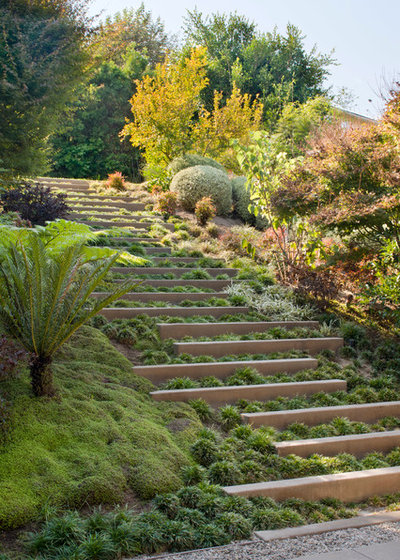
KAA Design
Rather than encouraging plants to invade from the sides, here is an example of how space has been left between the treads for designated plantings. With just one plant species in the design, it is a feature rather than just a stairway.
Plants with a clump-forming habit are perfect for this type of planted stairway, especially where the design requires one species to dominate. This includes some smaller grasses, such as blue fescue (
Festuca glauca, zones 4 to 8), blue sedge (
Carex flacca, zones 4 to 9),
variegated Japanese sedge (
Carex hachijoensis ‘Evergold’, zones 5 to 10) and grass-like
big blue lilyturf (
Liriope muscari, zones 5 to 11). These plants can handle light foot traffic and will need an additional step or to be used where there is infrequent foot traffic.
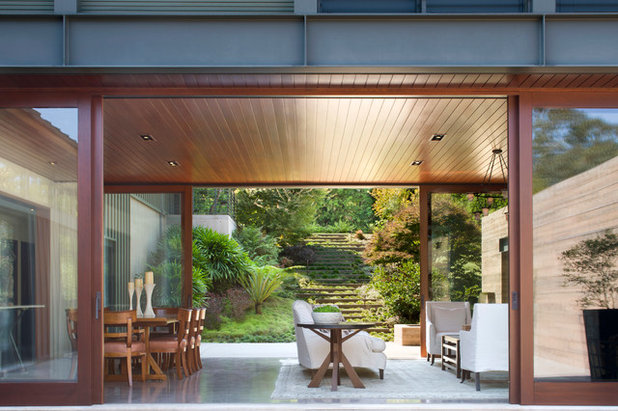
KAA Design
When we view it from the house, we can see what a wonderful feature the staircase is. The color of the risers blends with the colors of the house, while the softscape blends with the surrounding plantings.
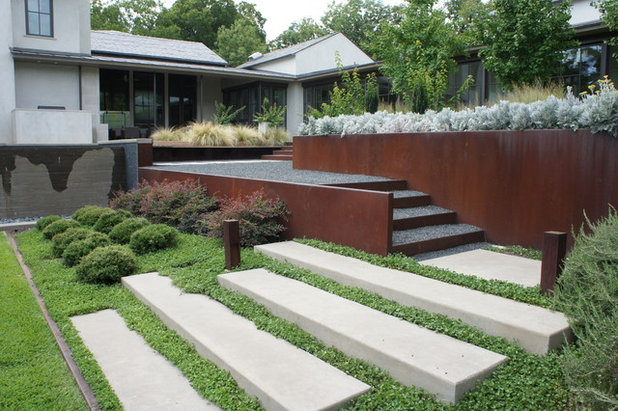
The Garden Design Studio
Simplicity is sometimes best. As with the previous example, step planting can work better when a single species dominates. West Coast native
Dichondra (
Dichondra occidentalis) encircles these clean-looking poured-concrete steps.
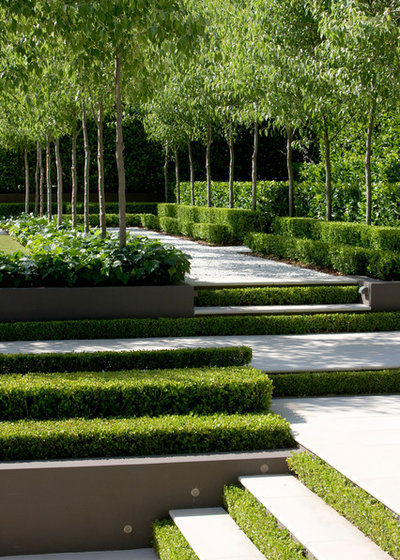
Peter Fudge Gardens
Boxwood (
Buxus sp) risers and stone steps are an alternative to the wayward appearance of crevice-growing plants and grasses. Unlike previous examples, these steps will need to be routinely clipped. Though boxwood is a good plant where tight clipping is required, there is always the danger of its contracting box blight (
Cylindrocladium buxicola), a fungal disease that discolors the foliage and can in time kill the plant.
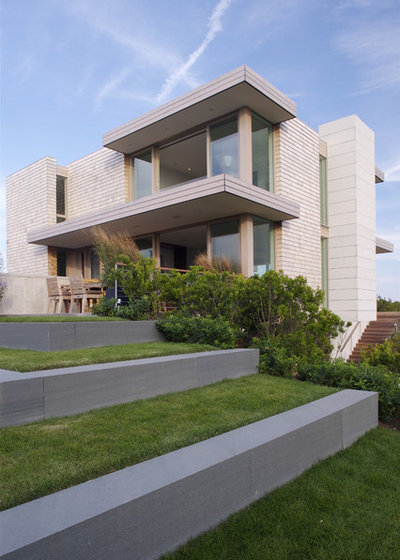
Stelle Lomont Rouhani Architects
Lawn can also soften steps in a minimalist garden. This look is far from the planted steps we’ve been looking at so far. The wide lawn treads and stone risers create the feeling of an amphitheater as the steps drop down from the open seating area, complementing the contemporary house.
The grass steps could also be planted as a meadow or splattered with naturalized bulbs. Left planted with the correct choice of grass, it’s an attractive, permeable landscape feature that can handle heavy foot traffic.
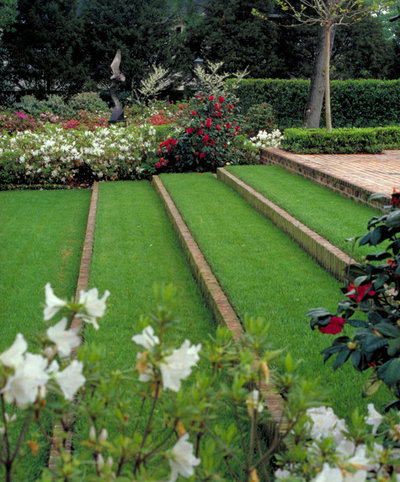
McDugald-Steele
On the other hand, these grassed steps perhaps need no planting embellishment at all. The detail of the brick risers perfectly matches the manicured grass treads.

GEL: Griffin Enright Landscape
Surely this stairway planted with
Korean grass (
Zoysia tenuifolia,
zones 7 to 9) is at the extreme end of step planting. Korean grass is an attractive, slow-growing ground cover that forms mounds or clumps. It can handle foot traffic and is usually mown or cut two to three times a year. It spreads by rhizomes (underground runners), which can grow into surrounding borders. Pink muhly grass (
Muhlenbergia capillaris) and
blue rye (
Leymus arenarius ‘Glaucus’) border the steps.





